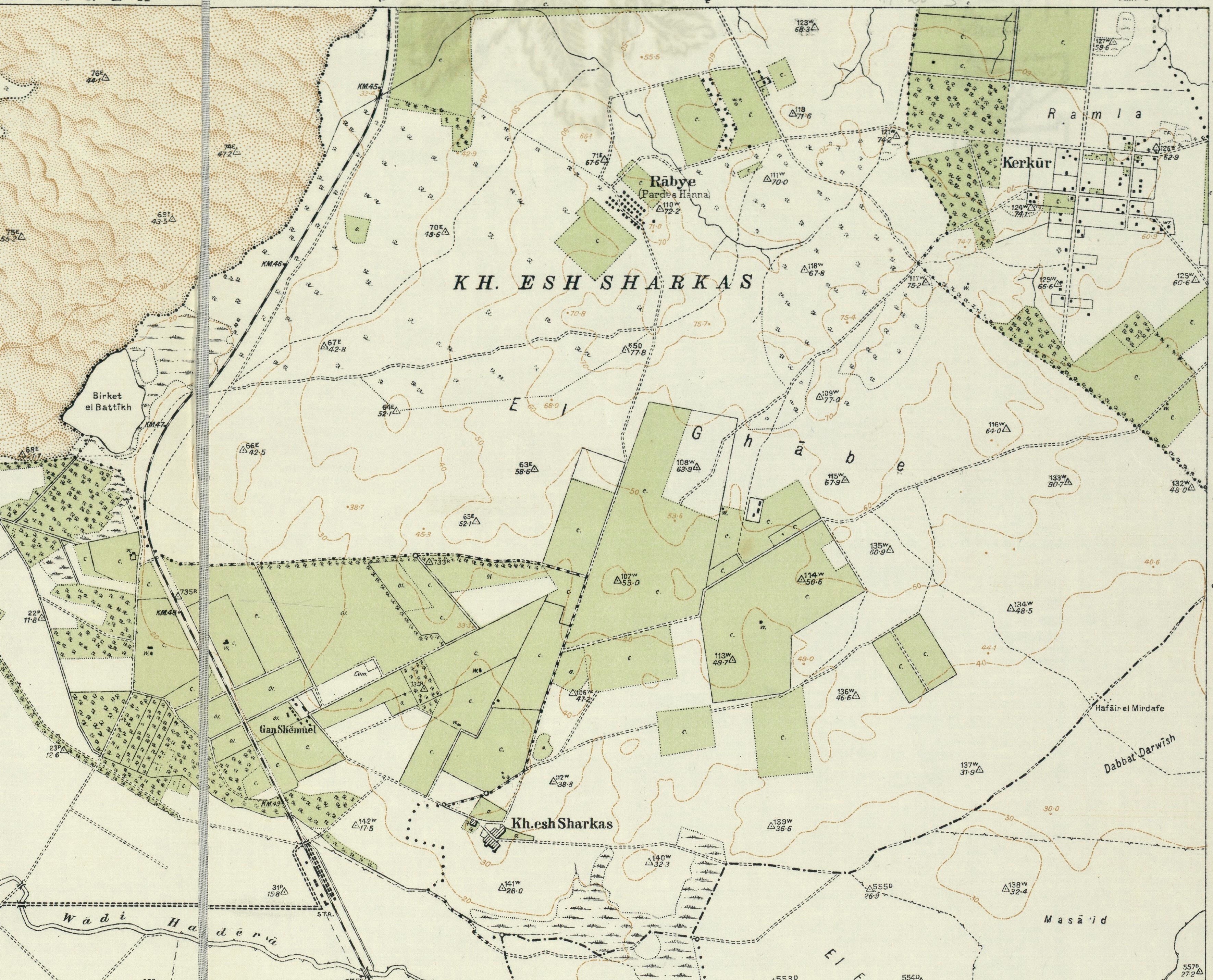|
Khirbat Al-Sarkas
Khirbat al-Sarkas ( ar, خربة السركس) was a village in Palestine, located 42 kilometres south of Haifa. It was depopulated during the 1948 Arab-Israeli war. History The village was founded by Circassians from Russia who were expelled from their country by the armies of the Czar in the 19th century, approximately 1860.Oliphant, 1887, p181 cited in Khalidi, 1992, p. 189 A population list from about 1887 showed that ''Jerakes'' had 130 Muslim inhabitants, who were noted as "Circassians”. The village was abandoned by the Circassians because of a Malaria epidemic. It was then settled by local Muslim Arabs. Gan Shmuel was established in 1913, about 1 km from the village. British Mandate era In the 1922 census of Palestine, conducted by the British Mandate authorities, Kherbet al-Sharkas had a population of 74; all Muslims, increasing sharply in the 1931 census to 383, still all Muslim, in a total of 80 houses.Mills, 1932, p 95/ref> 1948, aftermath Though th ... [...More Info...] [...Related Items...] OR: [Wikipedia] [Google] [Baidu] |
Mandatory Palestine
Mandatory Palestine ( ar, فلسطين الانتدابية '; he, פָּלֶשְׂתִּינָה (א״י) ', where "E.Y." indicates ''’Eretz Yiśrā’ēl'', the Land of Israel) was a geopolitical entity established between 1920 and 1948 in the region of Palestine under the terms of the League of Nations Mandate for Palestine. During the First World War (1914–1918), an Arab uprising against Ottoman rule and the British Empire's Egyptian Expeditionary Force under General Edmund Allenby drove the Ottoman Turks out of the Levant during the Sinai and Palestine Campaign. The United Kingdom had agreed in the McMahon–Hussein Correspondence that it would honour Arab independence if the Arabs revolted against the Ottoman Turks, but the two sides had different interpretations of this agreement, and in the end, the United Kingdom and France divided the area under the Sykes–Picot Agreementan act of betrayal in the eyes of the Arabs. Further complicating the issue was t ... [...More Info...] [...Related Items...] OR: [Wikipedia] [Google] [Baidu] |
Muslim
Muslims ( ar, المسلمون, , ) are people who adhere to Islam, a monotheistic religion belonging to the Abrahamic tradition. They consider the Quran, the foundational religious text of Islam, to be the verbatim word of the God of Abraham (or '' Allah'') as it was revealed to Muhammad, the main Islamic prophet. The majority of Muslims also follow the teachings and practices of Muhammad ('' sunnah'') as recorded in traditional accounts (''hadith''). With an estimated population of almost 1.9 billion followers as of 2020 year estimation, Muslims comprise more than 24.9% of the world's total population. In descending order, the percentage of people who identify as Muslims on each continental landmass stands at: 45% of Africa, 25% of Asia and Oceania (collectively), 6% of Europe, and 1% of the Americas. Additionally, in subdivided geographical regions, the figure stands at: 91% of the Middle East–North Africa, 90% of Central Asia, 65% of the Caucasus, 42% of Southeast As ... [...More Info...] [...Related Items...] OR: [Wikipedia] [Google] [Baidu] |
District Of Haifa
Haifa District ( he, מחוז חיפה, ''Mehoz Ḥeifa''; ar, منطقة حيفا) is an administrative district surrounding the city of Haifa, Israel. The district is one of the seven administrative districts of Israel, and its capital is Haifa. The district land area is 864 km2 (299.3 mi2). Demographics According to the Israeli Central Bureau of Statistics data for 2016: * Total population: 996,300 * Ethnic: ** Jews: 642,700 (69.4%) ** Arabs: 233,000 (25.1%) ** Others: 51,000 (5.5%) * Religious (as of 2017): ** Jews: 684,100 (68.6%) ** Muslims: 213,400 (21.4%) ** Druze: 26,300 (2.6%) ** Christians: 17,600 (1.7%) ** Not classified: 56,300 (5.6%) Administrative local authorities See also *Districts of Israel *List of cities in Israel *Arab localities in Israel *Wadi Ara Wadi Ara ( ar, وادي عارة, he, ואדי עארה) or Nahal 'Iron ( he, נחל עירון), is a valley and its surrounding area in Israel populated mainly by Arab Israelis. The area i ... [...More Info...] [...Related Items...] OR: [Wikipedia] [Google] [Baidu] |
Khalil Sakakini Cultural Center
Khalil Sakakini Cultural Center () is a leading Palestinian arts and culture organization that aims to create a pluralistic, critical liberating culture through research, query, and participation, and that provides an open space for the community to produce vibrant and liberating cultural content. Located in Ramallah, KSCC is housed in a renovated building, dating back to the early 20th century, based on traditional Palestinian architecture. Initially established in May 1996 as a branch of the Palestinian Ministry of Culture, KSCC was registered as a non-profit non-governmental organization (NGO) in 1998. The center is named after the Jerusalemite scholar, poet, and nationalist, Khalil Sakakini. The centre holds art exhibits, book readings, poetry readings, children's activities and film screenings. Additionally to long term projects KSCC has also transferred some of its activities to facilities outside Ramallah, such as to Birzeit, Gaza City, and Bethlehem, to enable continuatio ... [...More Info...] [...Related Items...] OR: [Wikipedia] [Google] [Baidu] |


.jpg)